iModeler Review: Trumpeter 1/35 Tiger I late w/Zimmerit (09540) – Part 1
This article is part of a series:
Finally, a Tiger. Said no one, ever.
Let's face it: The Tiger I has to be one of the most kitted tanks in the history of scale modeling. A quick check on the interwebs shows the impressive number of 96 different kits from at least 14 different manufacturers, and we are only talking 35th scale here. With total production numbers of around 1,350 for the real thing, it would not surprise me if we would see a separate kit for every single Tiger in a couple of years.
So why is it Trumpeter decided to enter the market with their own take on the Tiger I? I guess the answer is simple – German armor sells like hot cake, especially the feline variants like Tigers and Panthers. And just because there is a bunch of stuff out there doesn't mean there is no space for a slightly different approach.
The real thing.
This is not going to be an “all there is to know about the Tiger” section, more of a short overview to set the scene. If you are interested in the whole story, there is a couple of excellent websites dealing with this tank – and of course loads of books.
The Tiger I was the result of a request to design a heavy break-through tank, with the purpose of supporting the infantry in overcoming front-line defences. In that role it was intended to be a successor to the Panzer IV, should be armed with a long-barrelled 7,5cm gun, and weigh around 30 tons. After reviewing the designs submitted by Henschel, MAN, Daimler-Benz (yes, the Mercedes dudes), and Porsche (yes, the – well, Porsche dude), the German Army awarded development contracts to Henschel and Porsche, for an updated 45-ton design carrying a 8,8cm gun.
Development and testing were plagued with delays, most of them due to engine issues. The Porsche design especially proved to be troublesome, with its unusual approach of fuel-electric engines. Nonetheless, Porsche produced 90 hulls in the firm belief they would win the competition – in the end these hulls would be used as the basis for the Panzerjäger (tank destroyer) Ferdinand.
The Henschel design entered production in later summer of 1942, and the Tiger was first used in combat on the Leningrad front on 29th of August. From this time on, Tiger's would be used in every theatre of operations, including North Africa, Italy, and the western front.
Trumpeter's take on the Tiger. While brushing up your German.
Trumpeter announced the upcoming release of two Tiger I kits by the end of 2017, in the middle of a surge of German armor releases by various companies. With the mid production variant due soon, we are going to take a look at the “late” variant for now.
The official kit designation is “Pz.Kpfw. VI Ausf. E Sd.Kfz. 181 Tiger I (Late Production) w/Zimmerit”. And in case you were wondering, here's the solution to the riddle: “Pz.Kpfw.” is the abbreviation of “Panzerkampfwagen”, which means armored fighting vehicle. “Ausf.” is short for “Ausführung”, meaning variant. And “Sd.Kfz.” stands for “Sonderkraftfahrzeug”, which in turn translates to “special motorized vehicle”. And here's a pet peeve of mine: In lots of video reviews about German vehicles you hear the term “Ausf.” pronounced as just that – “We are talking about the Ausf X today”. Please don't. It's “Ausführung”, or simply “variant”. You are welcome.
The “Zimmerit” thing by the way refers to a concrete-like paste which was applied to the tank's metal surfaces to prevent magnetic mines from sticking to the hull or turret. But more on that later.
The kit comes in Trumpeter's standard box, a very sturdy piece of cardboard that should prevent any damage to parts during transit.
In the box you will find twelve bags of plastic parts, containing 15 sprues, the hull tub, hull top, and turret shell. Two small bags hold the decals and the PE fret. Another bag contains two flat sheets of pre-cut Zimmerit. The usual paperwork rounds off the kit's contents. All together we are talking about 510+ parts, including 188 track links.
Instructions and Markings.
The instructions come in the typical Trumpeter style, with a b/w instruction booklet and two separate four-color sheets for the painting options. The construction drawings are clear and lead to the final result in 21 steps. Given the fact there is no interior included, construction should be pretty straight forward. You will, however, need to decide at the start whether you want to build a version with or without Zimmerit.
The painting instructions only refer to AK Interactive “Real Color” paints (biting my tongue here…), but I guess it won't be too hard to find the appropriate paints from the brand of your choice. What strikes me as odd is that there is no mention whether a particular variant had Zimmerit applied or not, making the whole “choose up front”-thing a moot point.
The markings give you five options, including a vehicle used by the French Army. The other options are:
- Tank “312”, s.Pz.Abt. 505 (505th Heavy Tank Battalion), Poland 1944
- Tank “912”, SS-Pz.Rgt. 3 (3rd SS Tank Regiment), Poland 1944
- Tank ”132”, s.SS-Pz.Abt. 102, Cologne 1944
- Tank ”A12”, Pz.Rgt. Großdeutschland, Prussia 1944
The inclusion of tank 312 poses a slight issue, as this tank had the earlier, large variant of the muzzle brake and other small differences. Other tanks of the same unit seem to fit the kit's contents better, so you might want to go for a different vehicle number. Another thing to note if you decide to go that route is that the area where the “charging knight” was painted on the turret was kept free of Zimmerit, so some cutting of the provided sheets will be required.
Tank 132 shows a whole bunch of kill markings on the barrel - there is, however, no decal provided for these, so you will have an opportunity to practice your masking skills.
In general, the markings seem a bit sparse, lacking almost any unit insignia. As with most Trumpeter and Hobby Boss offerings, tanks as well as aircraft, I suggest consulting your references and/or using aftermarket decals.
The Main Course. Plastic.
The sprues, some of which are wrapped in Styrofoam to protect delicate parts, are a real pleasure to look at. Detail is very fine and crisp, with small attachment points and hardly any flash. Let's take a look at some of the details (overview images of all the sprues can be found at the bottom of this review).
The turret shell shows some very subtle casting texture, together with appropriately rough weld marks. Due to the molding process there are two fine seam lines which need to be removed, but this should not be a problem.
The turret roof depicts the late variant with the three “mushroom” sockets for mounting a crane, and a weld line running across the center of the roof. The rough texture on the commander's cupola ring looks beautiful, but shouldn't be there. This part was almost smooth, so I suggest sanding off the texture.
The hull sides and bottom again show cast texture, and various hatches and bolts.
The engine deck features crisp bolts and fixtures, as does the driver's area.
The rear hull plate, another example of delicate molding.
The escape hatch on the side of the turret can only be built in the closed position, but given the lack of an interior, this is okay.
The main gun comes in two pieces, to which the later small muzzle break (again two pieces) is attached. If this approach sounds old-school to you, that's because it is. Yes, this kit is cheap as chips (insert spoiler alert here), but I expected at least some slide molding for the barrel.
The gun mantlet is provided in two variants, one with and one without Zimmerit texture. The mantlet has a slight quirk, however – for a late Tiger variant, the depressions on the left side of the mantlet should not have rounded corners, but a sharp 90° corner instead. Fixing this with some cutting should not be an issue, however, especially if you intend to use the Zimmerit version with its generally rough appearance.
The rest of the parts look very good. The inside of the loader's hatch is free of pin marks and sports a rather convincing depiction of the closing mechanism.
The front fenders show fine latches and hinges. Of course some of us might want to replace these details with PE, but what is provided should be quite enough for the casual Tiger builder.
Speaking of fenders, the rear ones will need minor tweaking if you want to be thorough. The two cut-outs on each fender are mirrored in the kit, whereas the larger cut-out should be on the left side on both fenders. Some careful cutting and repositioning of the right fender's separating bar will fix this in no time.
The hull front plate includes one part of the hull machine gun's ball mount. This ring again should not have the heavy cast texture and needs to be smoothened out. That whole assembly was in fact one single part with a groove running around it, so the ring and the kit's separate front part should have the same smooth texture.
The turret bin is a simple two-part affair, again with some nice detail. It remains to be seen if the bin's roof will sit at its correct angle once installed, dropping slightly towards the rear.
Tools and tow cables look pretty solid, and with the rather complicated arrangement of cables I am tempted to use the kit's parts instead of fabricating my own from wire.
The commander's MG34 is a simple one-piece molding, to which a PE anti-air sight is attached. There is no ammunition drum provided, and the muzzle is not slide-molded, so you will have to drill it out yourself.
Due to the nature of the Tiger's suspension you will have to deal with a lot of wheels. We are talking about 32 road wheels, in addition to the usual sprockets and idler wheels. But with this being the late, all-steel wheels, at least you won't have to paint any rubber portions… The casting of these parts is again very nice, with detail on the front as well as the back of the road wheels.
An important aspect of every Tiger kit is the tracks. Being of the unsupported variety, they show characteristic sag which is very hard to replicate with rubber-band tracks. Trumpeter provides us with six sprues of separate track links which need to be glued together – sadly they are not workable. A bigger issue for some might be the guide horns. In reality, these horns featured lightening holes, whereas in the kit they are molded solid. There are plenty of aftermarket tracks on the market, but using them will increase the kit's cost considerably.
Zimmerit and PE.
Depicting this unique texture on German tanks has always been a tricky subject. In ye olden days, people went to work with soldering irons, melting the texture into a kit's parts. Putty was used as well, together with stamps replicating the various patterns seen on the real thing. Later on, manufacturers started molding kit parts with the Zimmerit texture already applied, which is nice but somewhat limits your options for depicting battle damage. And recently companies like Meng released kits which included decals with a rough texture.
Trumpeter's approach is to provide you with a sheet of plastic, much like the structured sheets Plastruct provides – but much thinner. These sheets can be glued with standard plastic glue like Tamiya Extra Thin, which makes applying and altering them to your taste a breeze. Downside with the sheets provided with this kit is the very precise nature of the texture – it almost looks too perfect, so you might want to roughen it up a bit in places.
Finally, the small PE fret contains the grating for the engine deck, and the AA sight for the MG34. Not much to see here, but I must say the interweaved character of the grating looks pretty good to me.
To sum it up…
This is literally the first kit of a German subject I hold in my hands since I was a kid. Not being a huge fan of the “dark side”, I must admit I absolutely like what I see. There are a couple of issues with this kit, like the lackluster markings and the outdated approach to the gun barrel, but in general this looks to be a very solid kit – and an excellent basis for your personal super Tiger.
This kit is not yet widely available, but should find its way into your favourite store very soon. I expect prices to be somewhere around 35-40 Euro for Europe and the US, while you can get it for some 20 Euro from some vendors in Asia. Which, in all honesty, is just ridiculous given the contents and the possibilities this kit offers.
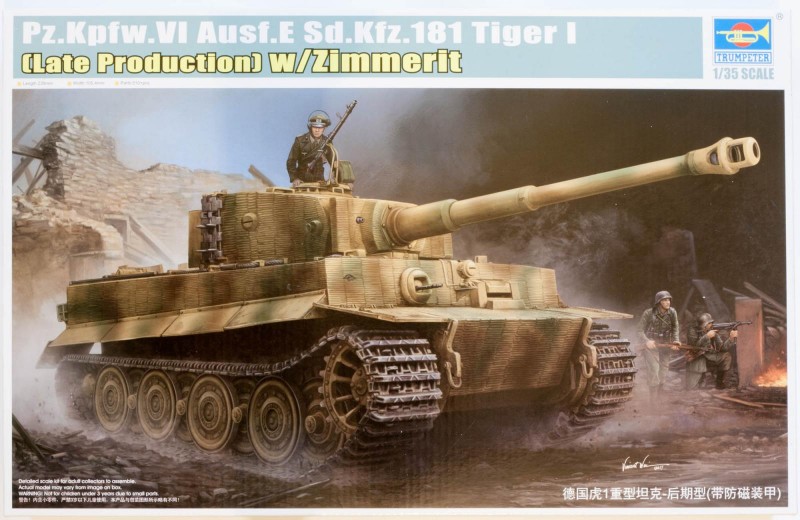
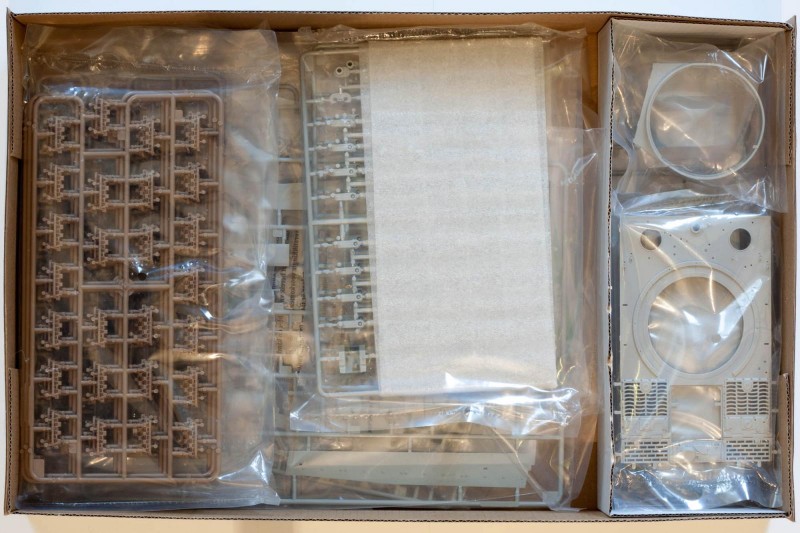







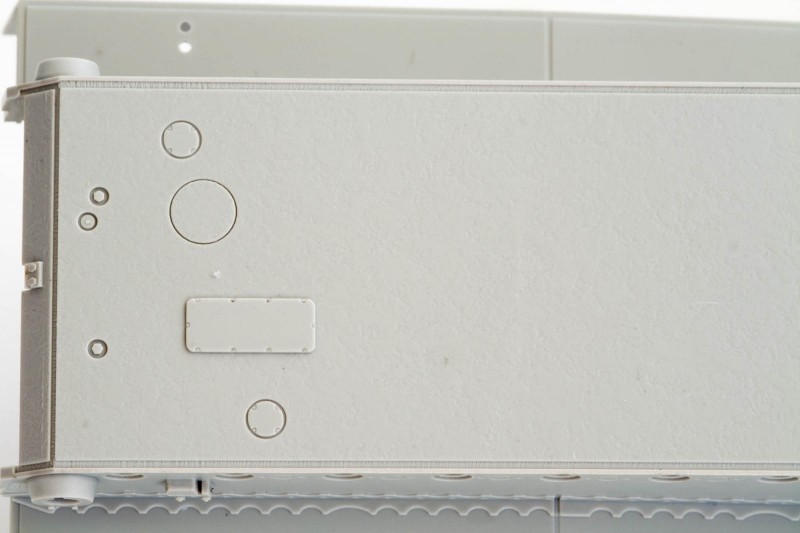




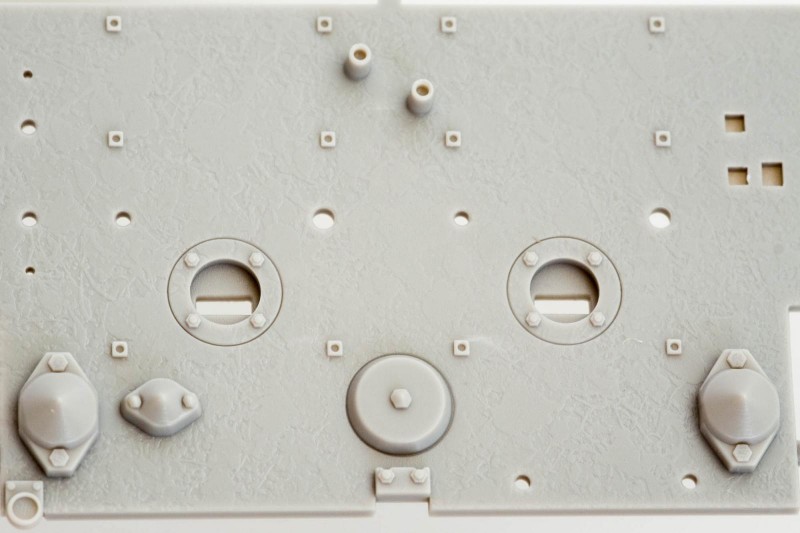


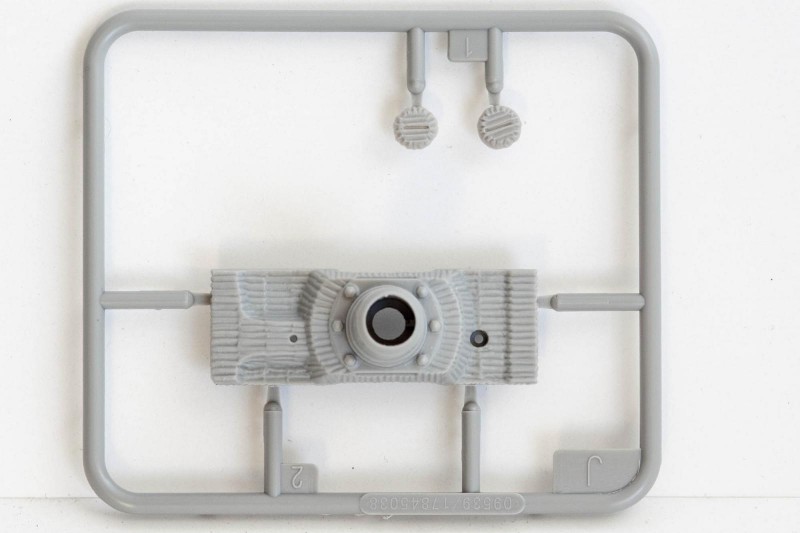
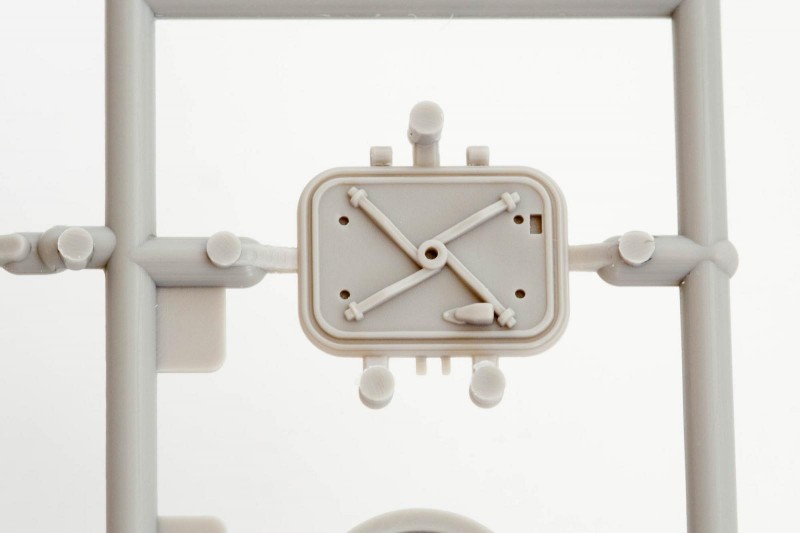
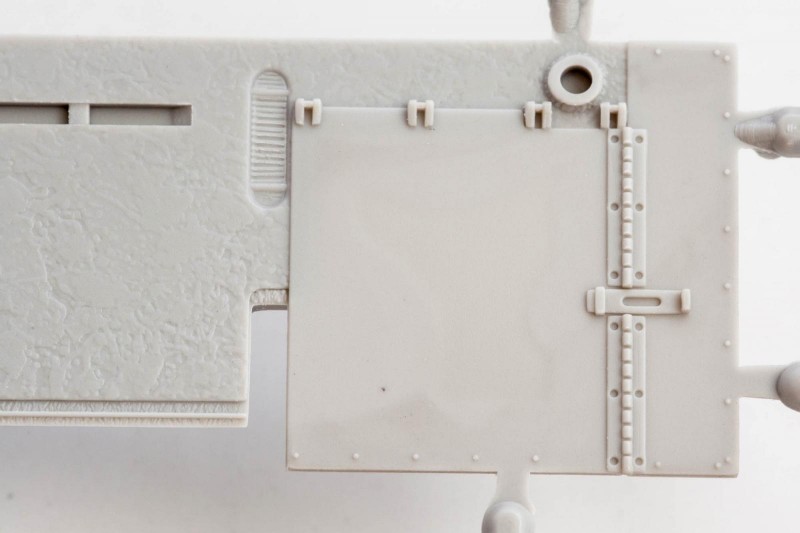






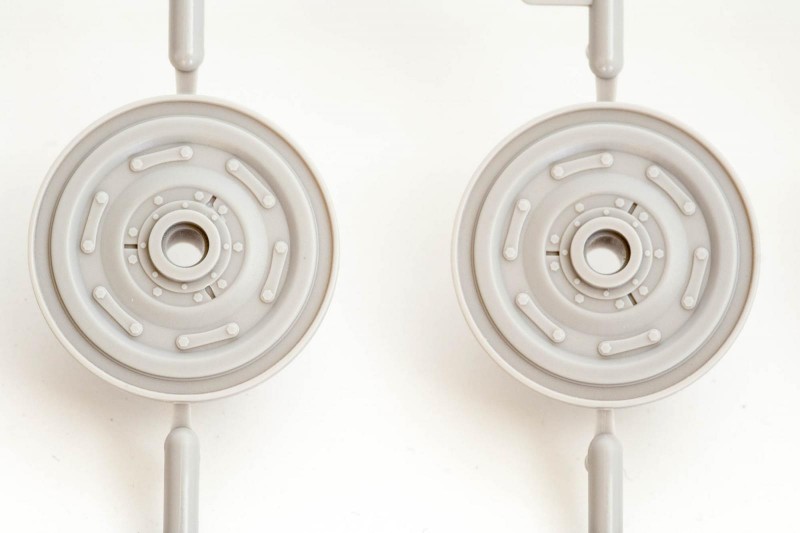






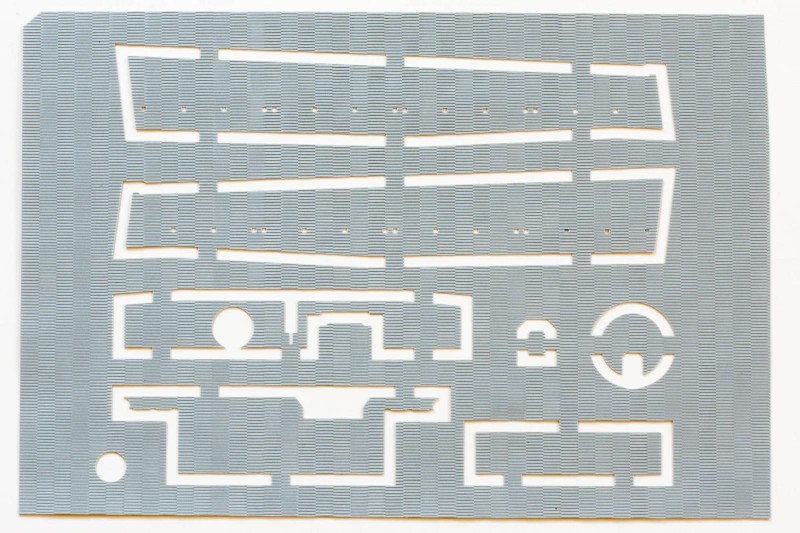














Well done Boris !
This is a very informative review. Like many here, I have quite a few Tiger's in the collection... Now it looks like I may have to add another one...
The close up pictures of the parts really help the reader see what is in store under the box lid ... I also like how you pointed out the good and the "Not so Good".
Thanks for the information on this one. The price for this one is going to be hard to beat.
Thanks Louis! Hope I didn't get you into trouble for any future additions to your stash
Great review, Boris! This looks like a great kit as is with the possibility of a kit with interior at a later date. IF desired. The add-on zimmerit looks like a good way to give the modeler a choice.
Thanks Jeff - as someone pointed out to me, all late Tigers should have the Zimmerit applied anyway, so it seems like for this kit there is in fact no choice. But I still think this is an interesting approach.
Great review for an equally great kit. Thanks.
Glad you liked it
Great review Boris, and that's from a guy who hasn't done a tank. But after this review I may have to start one.
Oh no, what have I done!
This Tanker thing is catching. Look what you did to Tom.
Great review, Boris. It seems to me that the Trumpeter is pretty close in terms of quality to the Dragon mid/late Tiger (also with Zimmerit); do you have a thought on which is best?
Thanks David! Funnily enough I had stepped away from armor for a couple of years, but came back - it's just too much fun
As to a comparison, I haven't seen the Dragon Tigers in the flesh, so I can only give you my second-hand impressions. I think they still have the edge when it comes to detail, with more PE, more options in the kit, and a more sophisticated design approach (slide-molded barrels etc.). When talking about late Tigers, Dragon's kit No 6383 is regarded to be the best option, giving you the best bang for the buck.
And here's the thing: When you start comparing prices, you will have to decide what you expect from a kit. Are you a real Tigeroholic (or insert Shermans, Mustangs, whatever)? Is it going to be a centerpiece of your collection? Or do you just want to get your feet wet on this subject, or maybe enjoy a quick and easy build and rather focus on painting and weathering? Trumpeter's offering will cost you 20 euro when ordered from Hong Kong, Dragon's 6383 will set you back 52 euros. Both are absolutely legitimate choices (hell, I spent more than that on a PE set for a kit), it just depends what you want.
Thanks, Boris. I'm just starting the Tamiya Mid Production, very definitely a 'getting my feet muddy' job rather than a Tigerphile. I know from the early engagements with the enemy that is will not be a one off fling, and I can see myself wanting to throw the kitchen sink at this at some point in the future.
I've already been salivating over the Friul tracks. A hopeless case, really. I did really enjoy your review and as Stephen says, it's very much from a 'modeler on the street' perspective. Appreciate you taking the time to reply.
Boris,
I've read a few reviews in my time and the usual review rely's on the writer to writer and the reader to trust whats been written. Reading a review that has been sugar coated and omits some of the finer points (fit issues) and then going out and buying a kit can be disappointing and you write off the reviewer. Or if the reviewer is a master modeler and putting together models,photographing them and sugar coating things for the benefit of the hobby/manufacturer and leaving out the reader/modeler who buy's something wonderfully good looking but, it becomes, a shelf of doom model... the kit gets written off and so does the writer. Since modeling is about making 3-D objects and handling the plastic and looking up close at the plastic ... photos about whats being written about is a added plus. Seeing is believing. I am sure at one time band width was a meditating factor and its easier to put up the written word but, given how the internet has evolved and allows the potential for a more democratic sharing of information the up close photos are a real service to the modeler on the street. Two thumbs up. Keep up the good work.
Stephen, thank you for your kind words. Honestly, writing a Tiger review feels a bit like entering a snake pit - there are lots of Experten out there who would gladly rip apart every single statement made in such an article. And of course you will always find someone to tell you that a) we don't need another Tiger and b) previous offerings by other manufacturers are way better anyway.
Being by no means a Tiger buff, I can only describe what I see and what a limited amount of research tells me. Hand me a Sherman kit and you'll see a legitimate rivet counter in action - but for the Tiger I can only offer a more "general modeller's" point of view. And from this perspective Trumpy's Tiger abolutely works for me.
That looks like one hell of a model Tiger! I want one. I have only built the Dragon Mid-Production Tiger in Grey. Time to build a new one and try this kit. Love the moldings. Great Review thank you!
1 attached image. Click to enlarge.
These kits are mesmerising. The detail now is perhaps over-engineered in places and I find the sprues interesting as a kind of artwork, just looking at the fine engineering, as much gets lost when everything comes together later.
One of the main tests is how well the treads play-out, particularly with Tigers and their characteristic ‘sag’.
A downside to armour is that once built they need a terrain display, so a further test of your skills in making a vignette or diorama; a tank sitting on a bare display base always looks a little lost, to me anyway.
Good review!
I have no intention of every building a Tiger (but, of course, you never know), however I really enjoyed your review, both the writing and the pictures. Looking forward to seeing how it builds up.